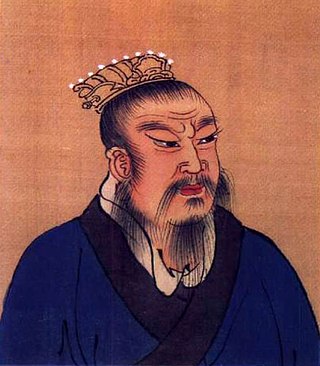
Sima Qian (司馬遷; was a Chinese historian during the early Han dynasty. He is considered the father of Chinese historiography for his Records of the Grand Historian, a general history of China covering more than two thousand years beginning from the rise of the legendary Yellow Emperor and the formation of the first Chinese polity to the reign of Emperor Wu of Han, during which Sima wrote. As the first universal history of the world as it was known to the ancient Chinese, the Records of the Grand Historian served as a model for official history-writing for subsequent Chinese dynasties and the Sinosphere in general until the 20th century.
The Xiongnu were a tribal confederation of nomadic peoples who, according to ancient Chinese sources, inhabited the eastern Eurasian Steppe from the 3rd century BC to the late 1st century AD. Modu Chanyu, the supreme leader after 209 BC, founded the Xiongnu Empire.

The Wusun were an ancient semi-nomadic steppe people mentioned in Chinese records from the 2nd century BC to the 5th century AD.

The Yuezhi (Chinese: 月氏; pinyin: Yuèzhī, Ròuzhī or Rùzhī; Wade–Giles: Yüeh4-chih1, Jou4-chih1 or Ju4-chih1;) were an ancient people first described in Chinese histories as nomadic pastoralists living in an arid grassland area in the western part of the modern Chinese province of Gansu, during the 1st millennium BC. After a major defeat at the hands of the Xiongnu in 176 BC, the Yuezhi split into two groups migrating in different directions: the Greater Yuezhi (Dà Yuèzhī 大月氏) and Lesser Yuezhi (Xiǎo Yuèzhī 小月氏). This started a complex domino effect that radiated in all directions and, in the process, set the course of history for much of Asia for centuries to come.

Emperor Gaozu of Han, also known by his given name Liu Bang (劉邦), was the founder and first emperor of the Han dynasty, reigning from 202 to 195 BC. He is considered by traditional Chinese historiography to be one the greatest emperors in history, credited with establishing the Pax Sinica, one of China's longest golden ages.

Deng Ai, courtesy name Shizai, was a Chinese military general and politician of the state of Wei during the Three Kingdoms period of China. He is best known for his pivotal role in the Wei conquest of its rival state, Shu, in 263. He was described as a very loyal subject who made great contributions to Wei, but was also noted for his arrogance and audacity, which led to his downfall and death.

The Yuwen is a Chinese compound surname originated from a pre-state clan of Xianbei ethnicity of Xiongnu origin during the era of Sixteen Kingdoms in China, until its destruction by Former Yan's prince Murong Huang in 345. Among the eastern Xianbei clans that ranged from the central part of the present day Liaoning province and eastward, Yuwen clan was the largest, and was awarded the position of the leader of eastern Xianbei (東部大人) by Chinese rulers. A descendant of the Yuwen tribe, Yuwen Tai, established the Northern Zhou Dynasty in the 6th century.
Yuanhe Xingzuan "The register of the great families from the Yuanhe reign (806-820)" vol. 6, the Yuwen part 2 records:
(宇文)本遼東南單于之後, 有普回因獵得玉璽, 以為天授. 鮮卑俗呼天子為宇文, 因號宇文氏.
(The Yuwen) originally were the descendants of the southern Shanyu. Someone within them called Puhui got a jade seal when he was hunting. This was regarded as a sign of imperial enthronement from heaven. According to Xianbei tradition, the son of the heaven was called the Yuwen. Thus (Puhui) called himself the Yuwen.

Zhong Hui, courtesy name Shiji, was a Chinese calligrapher, essayist, military general, and politician of the state of Cao Wei during the Three Kingdoms period of China. He was the younger son of Zhang Changpu with Zhong Yao, who served as the Grand Tutor in the Wei imperial court. He was already known for being insightful, intelligent and knowledgeable since he was young. Zhong Hui rose to prominence in the 250s when he became a close aide to Sima Zhao, the regent and de facto ruler of Wei. He advised Sima Zhao on how to deal with the Third Rebellion in Shouchun from 257 to 258 and was highly regarded by the latter. With Sima Zhao's help, Zhong Hui steadily moved up the ranks and became one of the key figures in the Wei government.

Chen Sheng, also known as Chen She, posthumously known as King Yin, was the leader of the Dazexiang Uprising, the first rebellion against the Qin Dynasty. It occurred during the reign of the Second Qin Emperor.
Liu Bao was a Southern Xiongnu leader who lived during the late Eastern Han dynasty and Three Kingdoms period of China. His son, Liu Yuan, founded the Han-Zhao dynasty during the Sixteen Kingdoms period.
Donghu was a tribal confederation of "Hu" (胡) nomadic people that was first recorded from the 7th century BCE and was taken over by the Xiongnu in 150 BCE. They lived in northern Hebei, southeastern Inner Mongolia and the western part of Liaoning, Jilin and Heilongjiang along the Yan Mountains and Greater Khingan Range.

The Ordos culture was a material culture occupying a region centered on the Ordos Loop during the Bronze and early Iron Age from c. 800 BCE to 150 BCE. The Ordos culture is known for significant finds of Scythian art and may represent the easternmost extension of Indo-European Eurasian nomads, such as the Saka, or may be linkable to Palaeo-Siberians or Yeniseians. Under the Qin and Han dynasties, the area came under the control of contemporaneous Chinese states.

Wuchuan, is a county of Inner Mongolia Autonomous Region, North China, it is under the administration of the prefecture-level city of Hohhot, the capital of Inner Mongolia. Wuchuan has an area of 4,885 km2 (1,886 sq mi) with a population of 95,869. It is connected to Hohhot by the Huwu Highway; roughly a half-hour's drive. Zhaohe Grasslands, a popular tourist site, is nearby.
Lu Wan was a Chinese military general, monarch, and politician who served as the vassal king of the early Han dynasty. He served under Liu Bang, the founding emperor of the Han dynasty.
Meng Yi was a Chinese military general and politician. As an official of the Qin dynasty, he served in the court of Qin Shi Huang. He was a younger brother of the general Meng Tian. After Qin Shi Huang's death, Meng Yi and his brother were executed by Qin Er Shi on the urging of Zhao Gao.

The Xianyun was an ancient nomadic tribe that invaded the Zhou dynasty. This Chinese exonym is written with xian獫 or 玁 "long-snouted dog", and this "dog" radical 犭 is commonly used in graphic pejorative characters. "Xianyun" was the preferred designation for northern tribes during the Zhou dynasty, earlier designations being the Xunyu, Guifang, and later ones being the Xiongnu, during the Han dynasty.

Guifang was an ancient ethnonym for a northern people that fought against the Shang Dynasty. Chinese historical tradition used various names, at different periods, for northern tribes such as Guifang, Rong, Di, Xunyu, Xianyun, or Xiongnu peoples. This Chinese exonym combines gui and fang, a suffix referring to "non-Shang or enemy countries that existed in and beyond the borders of the Shang polity."
Chunwei is a name associated with the Xiongnu, a tribal confederation of nomadic peoples who, according to ancient Chinese sources, inhabited the eastern Eurasian Steppe from the 3rd century BC to the late 1st century AD.
Princess Jieyou, born Liu Jieyou, was a Chinese princess sent to marry the leader of the Wusun kingdom as part of the Western Han Chinese policy of heqin.

Yiqu, was an ancient Chinese state which existed in the Hetao region and what is now Ningxia, eastern Gansu and northern Shaanxi during the Zhou dynasty, and was a centuries-long western rival of the state of Qin. It was inhabited by a semi-sinicized people called the Rong of Yiqu, who were regarded as a branch of western Rong people by contemporary writers, whom modern scholars have attempted to identify as one of the ancestors of the minority people in Northwest China.












